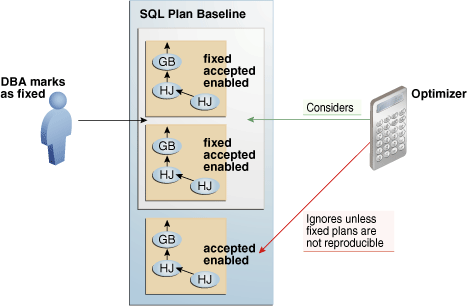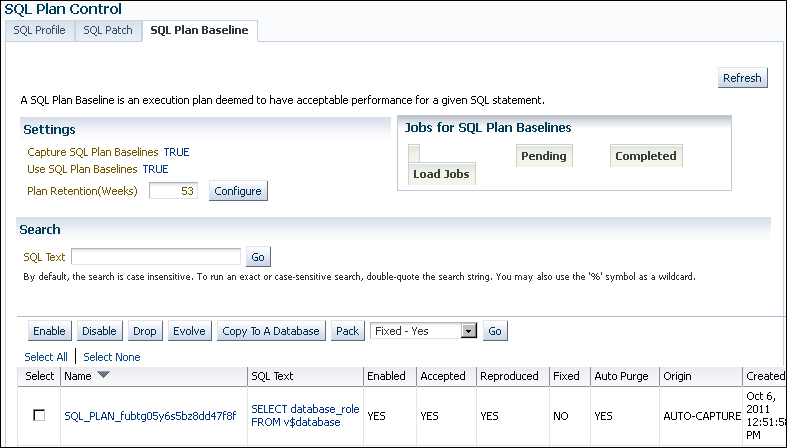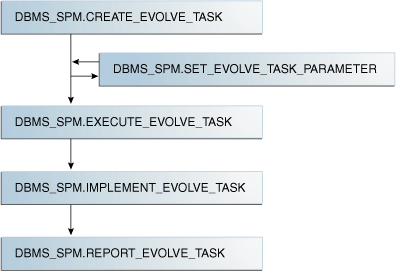23 Managing SQL Plan Baselines
This chapter explains the concepts and tasks relating to SQL plan management using the DBMS_SPM package.
This chapter contains the following topics:
23.1 About SQL Plan Management
SQL plan management is a preventative mechanism that enables the optimizer to automatically manage execution plans, ensuring that the database uses only known or verified plans. In this context, a plan includes all plan-related information (for example, SQL plan identifier, set of hints, bind values, and optimizer environment) that the optimizer needs to reproduce an execution plan.
SQL plan management uses a mechanism called a SQL plan baseline. A plan baseline is a set of accepted plans that the optimizer is allowed to use for a SQL statement. In the typical use case, the database accepts a plan into the plan baseline only after verifying that the plan performs well.
The main components of SQL plan management are as follows:
-
Plan capture
This component stores relevant information about plans for a set of SQL statements. See "Plan Capture".
-
Plan selection
This component is the detection by the optimizer of plan changes based on stored plan history, and the use of SQL plan baselines to select appropriate plans to avoid potential performance regressions. See "Plan Selection".
-
Plan evolution
This component is the process of adding new plans to existing SQL plan baselines, either manually or automatically. See "Plan Evolution".
This section contains the following topics:
23.1.1 Purpose of SQL Plan Management
The primary goal of SQL plan management is to prevent performance regressions caused by plan changes. A secondary goal is to gracefully adapt to changes such as new optimizer statistics or indexes by verifying and accepting only plan changes that improve performance.
Note:
SQL plan baselines cannot help when an event has caused irreversible execution plan changes, such as dropping an index.23.1.1.1 Benefits of SQL Plan Management
Typical scenarios in which SQL plan management can improve or preserve SQL performance include:
-
A database upgrade that installs a new optimizer version usually results in plan changes for a small percentage of SQL statements.
Most plan changes result in either improvement or no performance change. However, some plan changes may cause performance regressions. SQL plan baselines significantly minimize potential regressions resulting from an upgrade.
When you upgrade, the database only uses plans from the plan baseline. The database puts new plans that are not in the current baseline into a holding area, and later evaluates them to determine whether they use fewer resources than the current plan in the baseline. If the plans perform better, then the database promotes them into the baseline; otherwise, the database does not promote them.
-
Ongoing system and data changes can affect plans for some SQL statements, potentially causing performance regressions.
SQL plan baselines help minimize performance regressions and stabilize SQL performance.
-
Deployment of new application modules introduces new SQL statements into the database.
The application software may use appropriate SQL execution plans developed in a standard test configuration for the new statements. If the system configuration is significantly different from the test configuration, then the database can evolve SQL plan baselines over time to produce better performance.
See Also:
Oracle Database Upgrade Guide to learn how to upgrade an Oracle database23.1.1.2 Differences Between SQL Plan Baselines and SQL Profiles
Both SQL profiles and SQL plan baselines help improve the performance of SQL statements by ensuring that the optimizer uses only optimal plans. Both profiles and baselines are internally implemented using hints (see "About Optimizer Hints"). However, these mechanisms have the following significant differences:
-
In general, SQL plan baselines are proactive, whereas SQL profiles are reactive.
Typically, you create SQL plan baselines before significant performance problems occur. SQL plan baselines prevent the optimizer from using suboptimal plans in the future.
The database creates SQL profiles when you invoke SQL Tuning Advisor, which you do typically only after a SQL statement has shown high-load symptoms. SQL profiles are primarily useful by providing the ongoing resolution of optimizer mistakes that have led to suboptimal plans. Because the SQL profile mechanism is reactive, it cannot guarantee stable performance as drastic database changes occur.
The following graphic illustrates the difference:
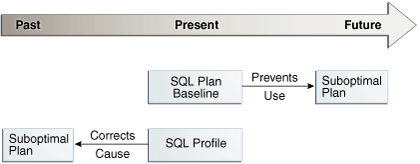
Description of the illustration tgsql_vm_028.png
-
SQL plan baselines reproduce a specific plan, whereas SQL profiles correct optimizer cost estimates.
A SQL plan baseline is a set of accepted plans. Each plan is implemented using a set of outline hints that fully specify a particular plan. SQL profiles are also implemented using hints, but these hints do not specify any specific plan. Rather, the hints correct miscalculations in the optimizer estimates that lead to suboptimal plans. For example, a hint may correct the cardinality estimate of a table.
Because a profile does not constrain the optimizer to any one plan, a SQL profile is more flexible than a SQL plan baseline. For example, changes in initialization parameters and optimizer statistics allow the optimizer to choose a better plan.
Oracle recommends that you use SQL Tuning Advisor. In this way, you follow the recommendations made by the advisor for SQL profiles and plan baselines rather than trying to determine which mechanism is best for each SQL statement.
23.1.2 Plan Capture
SQL plan capture refers to techniques for capturing and storing relevant information about plans in the SQL Management Base for a set of SQL statements. Capturing a plan means making SQL plan management aware of this plan.
You can configure initial plan capture to occur automatically by setting an initialization parameter, or you can capture plans manually by using the DBMS_SPM package.
23.1.2.1 Automatic Initial Plan Capture
You enable automatic initial plan capture by setting the initialization parameter OPTIMIZER_CAPTURE_SQL_PLAN_BASELINES to true (the default is false). When enabled, the database automatically creates a SQL plan baseline for any repeatable SQL statement executed on the database.
If automatic initial plan capture is enabled, and if the database executes a repeatable SQL statement, then the capture algorithm is as follows:
-
If a SQL plan baseline does not exist, then the optimizer creates a plan history and SQL plan baseline for the statement, marking the initial plan for the statement as accepted and adding it to the SQL plan baseline.
-
If a SQL plan baseline exists, then the optimizer behavior depends on the cost-based plan derived at parse time:
-
If this plan does not match a plan in the SQL plan baseline, then the optimizer marks the new plan as unaccepted and adds it to the SQL plan baseline.
-
If this plan does match a plan in the SQL plan baseline, then nothing is added to the SQL plan baseline.
-
The following graphic shows the decision tree for automatic initial plan capture when OPTIMIZER_USE_SQL_PLAN_BASELINES is set to true (see "Plan Selection" for more information):
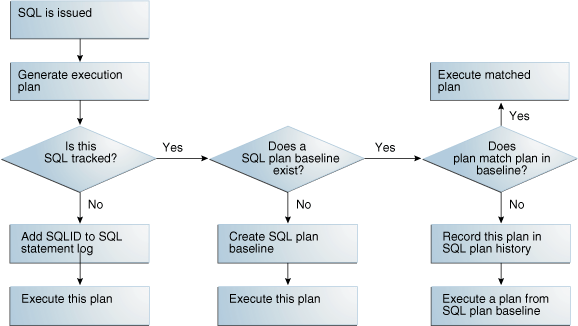
Description of the illustration tgsql_vm_004.png
Note:
The settings ofOPTIMIZER_CAPTURE_SQL_PLAN_BASELINES and OPTIMIZER_USE_SQL_PLAN_BASELINES are independent. For example, if OPTIMIZER_CAPTURE_SQL_PLAN_BASELINES is true, then the database creates initial plan baselines regardless of whether OPTIMIZER_USE_SQL_PLAN_BASELINES is true or false.See Also:
Oracle Database Reference to learn about theOPTIMIZER_USE_SQL_PLAN_BASELINES initialization parameter23.1.2.2 Manual Plan Capture
In SQL plan management, manual plan capture refers to the user-initiated bulk load of existing plans into a SQL plan baseline. Use Cloud Control or PL/SQL to load the execution plans for SQL statements from a SQL tuning set (STS), the shared SQL area, a staging table, or a stored outline.
The following graphic illustrates loading plans into a SQL plan baseline.
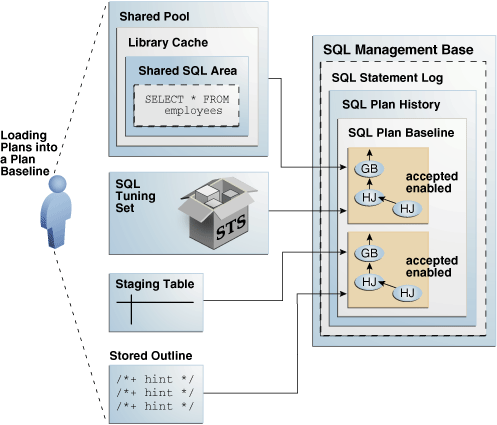
Description of the illustration tgsql_vm_007.png
The loading behavior varies depending on whether a SQL plan baseline exists for each statement represented in the bulk load:
-
If a baseline for the statement does not exist, then the database does the following:
-
Creates a plan history and plan baseline for the statement
-
Marks the initial plan for the statement as accepted
-
Adds the plan to the new baseline
-
-
If a baseline for the statement exists, then the database does the following:
-
Marks the loaded plan as accepted
-
Adds the plan to the plan baseline for the statement without verifying the plan's performance
-
Manually loaded plans are always marked accepted because the optimizer assumes that any plan loaded manually by the administrator has acceptable performance.
23.1.3 Plan Selection
SQL plan selection is the optimizer ability to detect plan changes based on stored plan history, and the use of SQL plan baselines to select plans to avoid potential performance regressions.
When the database performs a hard parse of a SQL statement, the optimizer generates a best-cost plan. By default, the optimizer then attempts to find a matching plan in the SQL plan baseline for the statement. If no plan baseline exists, then the database runs the statement with the best-cost plan.
If a plan baseline exists, then the optimizer behavior depends on whether the newly generated plan is in the plan baseline:
-
If the new plan is in the baseline, then the database executes the statement using the found plan.
-
If the new plan is not in the baseline, then the optimizer marks the newly generated plan as unaccepted and adds it to the plan history. Optimizer behavior depends on the contents of the plan baseline:
-
If fixed plans exist in the plan baseline, then the optimizer uses the fixed plan (see "Fixed Plans") with the lowest cost.
-
If no fixed plans exist in the plan baseline, then the optimizer uses the baseline plan with the lowest cost.
-
If no reproducible plans exist in the plan baseline, which could happen if every plan in the baseline referred to a dropped index, then the optimizer uses the newly generated cost-based plan.
-
The following graphic shows the decision tree for SQL plan selection.
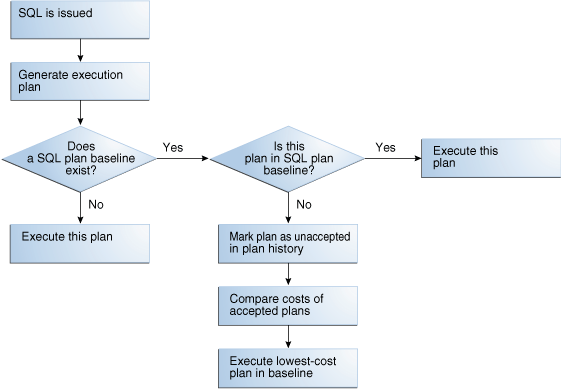
Description of the illustration tgsql_vm_003.png
23.1.4 Plan Evolution
In general, SQL plan evolution is the process by which the optimizer verifies new plans and adds them to an existing SQL plan baseline. Specifically, plan evolution consists of the following distinct steps:
-
Verifying that unaccepted plans perform at least as well as accepted plans in a SQL plan baseline (known as plan verification)
-
Adding unaccepted plans to the plan baseline as accepted plans after the database has proved that they perform as well as accepted plans
In the standard case of plan evolution, the optimizer performs the preceding steps sequentially, so that a new plan is not usable by SQL plan management until the optimizer verifies plan performance relative to the SQL plan baseline. However, you can configure SQL plan management to perform one step without performing the other. The following graphic shows the possible paths for plan evolution:
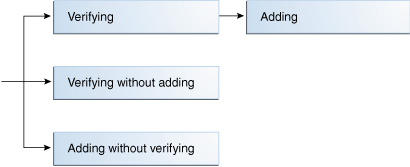
Description of the illustration tgsql_vm_023.png
23.1.4.1 Purpose of Plan Evolution
Typically, a SQL plan baseline for a SQL statement starts with a single accepted plan. However, some SQL statements perform well when executed with different plans under different conditions. For example, a SQL statement with bind variables whose values result in different selectivities may have several optimal plans. Creating a materialized view or an index or repartitioning a table may make current plans more expensive than other plans.
If new plans were never added to SQL plan baselines, then the performance of some SQL statements might degrade. Thus, it is sometimes necessary to evolve newly accepted plans into SQL plan baselines. Plan evolution prevents performance regressions by verifying the performance of a new plan before including it in a SQL plan baseline.
23.1.4.2 PL/SQL Procedures for Plan Evolution
The DBMS_SPM package provides procedures and functions for plan evolution. These procedures use the task infrastructure. For example, CREATE_EVOLVE_TASK creates an evolution task, whereas EXECUTE_EVOLVE_TASK executes it. All task evolution procedures have the string EVOLVE_TASK in the name.
Use the evolve procedures on demand, or configure the procedures to run automatically. The automatic maintenance task SYS_AUTO_SPM_EVOLVE_TASK executes daily in the scheduled maintenance window. The task perform the following actions automatically:
-
Selects and ranks unaccepted plans for verification
-
Accepts each plan if it satisfies the performance threshold
See Also:
-
Oracle Database PL/SQL Packages and Types Reference to learn about the
DBMS_SPMpackage
23.1.5 Storage Architecture for SQL Plan Management
This section describes the SQL plan management storage architecture:
23.1.5.1 SQL Management Base
The SQL management base (SMB) is a logical repository in the data dictionary that contains the following:
-
SQL statement log, which contains only SQL IDs
-
SQL plan history, which includes the SQL plan baselines
-
SQL profiles
-
SQL patches
The SMB stores information that the optimizer can use to maintain or improve SQL performance.
The SMB resides in the SYSAUX tablespace and uses automatic segment-space management. Because the SMB is located entirely within the SYSAUX tablespace, the database does not use SQL plan management and SQL tuning features when this tablespace is unavailable.
The following graphic illustrates the SMB architecture.
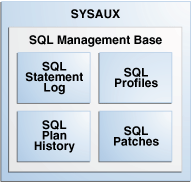
Description of the illustration tgsql_vm_002.png
Note:
Data visibility and privilege requirements may differ when using the SMB with pluggable databases. See Oracle Database Administrator's Guide for a table that summarizes how manageability features work in a container database (CDB).23.1.5.2 SQL Statement Log
When automatic SQL plan capture is enabled, the SQL statement log contains the SQL ID of SQL statements that the optimizer has evaluated over time. The database tracks a statement when its SQL ID exists in the SQL statement log. When the database parses or executes a statement that is tracked, the database recognizes it as a repeatable SQL statement.
Example 23-1 Logging SQL Statements
This example illustrates how the database tracks statements in the statement log and creates baselines automatically for repeatable statements. An initial query of the statement log shows no tracked SQL statements. After a query of hr.jobs for AD_PRES, the log shows one tracked statement.
SQL> ALTER SYSTEM SET OPTIMIZER_CAPTURE_SQL_PLAN_BASELINES=true; System altered. SQL> SELECT * FROM SQLLOG$; no rows selected SQL> SELECT job_title FROM hr.jobs WHERE job_id = 'AD_PRES'; JOB_TITLE ----------------------------------- President SQL> SELECT * FROM SQLLOG$; SIGNATURE BATCH# ---------- ---------- 1.8096E+19 1
Now the session executes a different jobs query. The log shows two tracked statements:
SQL> SELECT job_title FROM hr.jobs WHERE job_id='PR_REP'; JOB_TITLE ----------------------------------- Public Relations Representative SQL> SELECT * FROM SQLLOG$; SIGNATURE BATCH# ---------- ---------- 1.7971E+19 1 1.8096E+19 1
A query of DBA_SQL_PLAN_BASELINES shows that no baseline for either statement exists because neither statement is repeatable:
SQL> SELECT SQL_HANDLE, SQL_TEXT 2 FROM DBA_SQL_PLAN_BASELINES 3 WHERE SQL_TEXT LIKE 'SELECT job_title%'; no rows selected
The session executes the query for job_id='PR_REP' a second time. Because this statement is now repeatable, and because automatic SQL plan capture is enabled, the database creates a plan baseline for this statement. The query for job_id='AD_PRES' has only been executed once, so no plan baseline exists for it.
SQL> SELECT job_title FROM hr.jobs WHERE job_id='PR_REP';
JOB_TITLE
-----------------------------------
Public Relations Representative
SQL> SELECT SQL_HANDLE, SQL_TEXT
2 FROM DBA_SQL_PLAN_BASELINES
3 WHERE SQL_TEXT LIKE 'SELECT job_title%';
SQL_HANDLE SQL_TEXT
-------------------- --------------------
SQL_f9676a330f972dd5 SELECT job_title FRO
M hr.jobs WHERE job_
id='PR_REP'
See Also:
-
Oracle Database Reference to learn about
DBA_SQL_PLAN_BASELINES
23.1.5.3 SQL Plan History
The SQL plan history is the set of plans generated for a repeatable SQL statement over time. The history contains both SQL plan baselines and unaccepted plans.
In SQL plan management, the database detects plan changes and records the new plan in the history so that the DBA can manually evolve (verify) it. Because ad hoc SQL statements do not repeat and so do not have performance degradation, the database maintains plan history only for repeatable SQL statements.
Starting in Oracle Database 12c, the SMB stores the rows for new plans added to the plan history of a SQL statement. The DBMS_XPLAN.DISPLAY_SQL_PLAN_BASELINE function fetches and displays the plan from the SMB. For plans created before Oracle Database 12c, the function must compile the SQL statement and generate the plan because the SMB does not store the rows.
See Also:
-
Oracle Database PL/SQL Packages and Types Reference to learn about the
DBMS_XPLAN.DISPLAY_SQL_PLAN_BASELINEfunction
23.1.5.3.1 Enabled Plans
An enabled plan is eligible for use by the optimizer. The database automatically marks all plans in the plan history as enabled even if they are still unaccepted. You can manually change an enabled plan to a disabled plan, which means the optimizer can no longer use the plan even if it is accepted.
23.1.5.3.2 Accepted Plans
A plan is accepted if and only if it is in the plan baseline. The plan history for a statement contains all plans, both accepted and unaccepted. After the optimizer generates the first accepted plan in a plan baseline, every subsequent unaccepted plan is added to the plan history, awaiting verification, but is not in the SQL plan baseline.
Figure 23-1 shows plan histories for three different SQL statements. The SQL plan baseline for one statement contains two accepted plans. The plan history for this statement includes two unaccepted plans. A DBA has marked one unaccepted plan as disabled so that the optimizer cannot use it.
Figure 23-1 SQL Plan Management Architecture
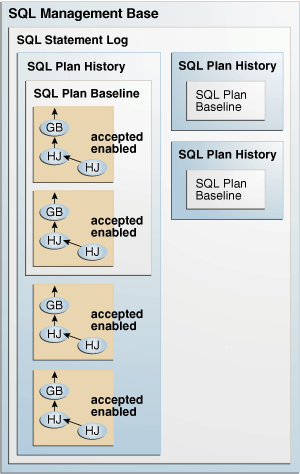
Description of "Figure 23-1 SQL Plan Management Architecture"
23.1.5.3.3 Fixed Plans
A fixed plan is an accepted plan that is marked as preferred, so that the optimizer considers only the fixed plans in the baseline. Fixed plans influence the plan selection process of the optimizer.
Assume that three plans exist in the SQL plan baseline for a statement. You want the optimizer to give preferential treatment to only two of the plans. As shown in Figure 23-2, you mark these two plans as fixed so that the optimizer uses only the best plan from these two, ignoring the other plans.
If new plans are added to a baseline that contains at least one enabled fixed plan, then the optimizer cannot use the new plans until you manually declare them as fixed.
23.1.6 User Interfaces for SQL Plan Management
Access the DBMS_SPM package through Cloud Control or through the command line.
23.1.6.1 SQL Plan Baseline Page in Cloud Control
The SQL Plan Control page in Cloud Control is a GUI that shows information about SQL profiles, SQL patches, and SQL plan baselines.
To access the SQL Plan Baseline page:
-
Access the Database Home page, as described in "Accessing the Database Home Page in Cloud Control."
-
From the Performance menu, select SQL, then SQL Plan Control.
The SQL Plan Control page appears.
-
Click Files to view the SQL Plan Baseline subpage, shown in Figure 23-3.
You can perform most SQL plan management tasks in this page or in pages accessed through this page.
See Also:
-
Cloud Control context-sensitive online help to learn about the options on the SQL Plan Baseline subpage
23.1.6.2 DBMS_SPM Package
On the command line, use the DBMS_SPM and DBMS_XPLAN PL/SQL packages to perform most SQL plan management tasks. Table 23-1 describes the most relevant DBMS_SPM procedures and functions for creating, dropping, and loading SQL plan baselines.
Table 23-1 DBMS_SPM Procedures and Functions
| Package | Procedure or Function | Description |
|---|---|---|
|
|
|
This procedure changes configuration options for the SMB in name/value format. |
|
|
|
This procedure creates a staging table that enables you to transport SQL plan baselines from one database to another. |
|
|
|
This function drops some or all plans in a plan baseline. |
|
|
|
This function loads plans in the shared SQL area (also called the cursor cache) into SQL plan baselines. |
|
|
|
This function loads plans in an STS into SQL plan baselines. |
|
|
|
This function packs SQL plan baselines, which means that it copies them from the SMB into a staging table. |
|
|
|
This function unpacks SQL plan baselines, which means that it copies SQL plan baselines from a staging table into the SMB. |
|
|
|
This function displays one or more execution plans for the SQL statement identified by SQL handle. |
"About the DBMS_SPM Evolve Functions" describes the functions related to SQL plan evolution.
23.1.7 Basic Tasks in SQL Plan Management
This section explains the basic tasks in using SQL plan management to prevent plan regressions and permit the optimizer to consider new plans. The tasks are as follows:
-
Set initialization parameters to control whether the database captures and uses SQL plan baselines, and whether it evolves new plans.
-
Display plans in a SQL plan baseline.
-
Manually load plans into SQL plan baselines.
Load plans from SQL tuning sets, the shared SQL area, a staging table, or stored outlines.
-
Manually evolve plans into SQL plan baselines.
Use PL/SQL to verify the performance of specified plans and add them to plan baselines.
-
Drop all or some plans in SQL plan baselines.
-
Manage the SMB.
Alter disk space limits and change the length of the plan retention policy.
-
Migrate stored outlines to SQL plan baselines.
23.2 Configuring SQL Plan Management
This section contains the following topics:
23.2.1 Configuring the Capture and Use of SQL Plan Baselines
You control SQL plan management with initialization parameters. The default values are as follows:
-
OPTIMIZER_CAPTURE_SQL_PLAN_BASELINES=falseFor any repeatable SQL statement that does not already exist in the plan history, the database does not automatically create an initial SQL plan baseline for the statement. See "Automatic Initial Plan Capture".
-
OPTIMIZER_USE_SQL_PLAN_BASELINES=trueFor any SQL statement that has an existing SQL plan baseline, the database automatically adds new plans to the SQL plan baseline as nonaccepted plans. See "Plan Selection".
Note:
The settings of the preceding parameters are independent of each other. For example, ifOPTIMIZER_CAPTURE_SQL_PLAN_BASELINES is true, then the database creates initial plan baselines for new statements even if OPTIMIZER_USE_SQL_PLAN_BASELINES is false.If the default behavior is what you intend, then skip this section.
The following sections explain how to change the default parameter settings from the command line. If you use Cloud Control, then set these parameters in the SQL Plan Baseline subpage (shown in Figure 23-3).
23.2.1.1 Enabling Automatic Initial Plan Capture for SQL Plan Management
Setting the OPTIMIZER_CAPTURE_SQL_PLAN_BASELINES initialization parameter to true is all that is necessary for the database to automatically create an initial SQL plan baseline for any SQL statement not already in the plan history. This parameter does not control the automatic addition of newly discovered plans to a previously created SQL plan baseline.
Caution:
When automatic baseline capture is enabled, the database creates a SQL plan baseline for every repeatable statement, including all recursive SQL and monitoring SQL. Thus, automatic capture may result in the creation of an extremely large number of plan baselines.To enable automatic initial plan capture for SQL plan management:
-
Connect SQL*Plus to the database with the appropriate privileges, and then show the current settings for SQL plan management.
For example, connect SQL*Plus to the database with administrator privileges and execute the following command (sample output included):
SQL> SHOW PARAMETER SQL_PLAN NAME TYPE VALUE ------------------------------------ ----------- ------------------------------ optimizer_capture_sql_plan_baselines boolean FALSE optimizer_use_sql_plan_baselines boolean TRUE
If the parameters are set as you intend, then skip the remaining steps.
-
To enable the automatic recognition of repeatable SQL statements and the generation of SQL plan baselines for these statements, enter the following statement:
SQL> ALTER SYSTEM SET OPTIMIZER_CAPTURE_SQL_PLAN_BASELINES=true;
23.2.1.2 Disabling All SQL Plan Baselines
When you set the OPTIMIZER_USE_SQL_PLAN_BASELINES initialization parameter to false, the database does not use any plan baselines in the database. Typically, you might want to disable one or two plan baselines, but not all of them. A possible use case might be testing the benefits of SQL plan management.
To disable all SQL plan baselines in the database:
-
Connect SQL*Plus to the database with the appropriate privileges, and then show the current settings for SQL plan management.
For example, connect SQL*Plus to the database with administrator privileges and execute the following command (sample output included):
SQL> SHOW PARAMETER SQL_PLAN NAME TYPE VALUE ------------------------------------ ----------- ------------------------------ optimizer_capture_sql_plan_baselines boolean FALSE optimizer_use_sql_plan_baselines boolean TRUE
If the parameters are set as you intend, then skip the remaining steps.
-
To ignore all existing plan baselines enter the following statement:
SQL> ALTER SYSTEM SET OPTIMIZER_USE_SQL_PLAN_BASELINES=false;
See Also:
Oracle Database Reference to learn about the SQL plan baseline initialization parameters23.2.2 Managing the SPM Evolve Advisor Task
SPM Evolve Advisor is a SQL advisor that evolves plans that have recently been added to the SQL plan baseline. The advisor simplifies plan evolution by eliminating the requirement to do it manually.
By default, SYS_AUTO_SPM_EVOLVE_TASK runs daily in the scheduled maintenance window. The SPM Evolve Advisor task ranks all unaccepted plans, and then performs test executions of as many plans as possible during the window. The evolve task selects the lowest-cost plan to compare against each unaccepted plan. If a plan performs sufficiently better than the existing accepted plan, then the database automatically accepts it. The task can accept more than one plan.
23.2.2.1 Enabling and Disabling the SPM Evolve Advisor Task
No separate scheduler client exists for the Automatic SPM Evolve Advisor task. One client controls both Automatic SQL Tuning Advisor and Automatic SPM Evolve Advisor. Thus, the same task enables or disables both. See "Enabling and Disabling the Automatic SQL Tuning Task" to learn how to enable and disable Automatic SPM Evolve Advisor.
23.2.2.2 Configuring the Automatic SPM Evolve Advisor Task
The DBMS_SPM package enables you to configure automatic plan evolution by specifying the task parameters using the SET_EVOLVE_TASK_PARAMETER procedure. Because the task is owned by SYS, only SYS can set task parameters.
The ACCEPT_PLANS tuning task parameter specifies whether to accept recommended plans automatically. When ACCEPT_PLANS is true (default), SQL plan management automatically accepts all plans recommended by the task. When set to false, the task verifies the plans and generates a report if its findings, but does not evolve the plans.
The tutorial in this section assumes the following:
-
You do not want the database to evolve plans automatically.
-
You want the task to time out after 1200 seconds per execution.
To set automatic evolution task parameters:
-
Connect SQL*Plus to the database with the appropriate privileges, and then optionally query the current task settings.
For example, connect SQL*Plus to the database with administrator privileges and execute the following query:
COL PARAMETER_NAME FORMAT a25 COL VALUE FORMAT a10 SELECT PARAMETER_NAME, PARAMETER_VALUE AS "VALUE" FROM DBA_ADVISOR_PARAMETERS WHERE ( (TASK_NAME = 'SYS_AUTO_SPM_EVOLVE_TASK') AND ( (PARAMETER_NAME = 'ACCEPT_PLANS') OR (PARAMETER_NAME = 'TIME_LIMIT') ) );Sample output appears as follows:
PARAMETER_NAME VALUE ------------------------- ---------- ACCEPT_PLANS TRUE TIME_LIMIT 3600
-
Set parameters using PL/SQL code of the following form:
BEGIN DBMS_SPM.SET_EVOLVE_TASK_PARAMETER( task_name => 'SYS_AUTO_SPM_EVOLVE_TASK' , parameter => parameter_name , value => value ); END; /For example, the following PL/SQL block sets a time limit to 20 minutes, and also automatically accepts plans:
BEGIN DBMS_SPM.SET_EVOLVE_TASK_PARAMETER( task_name => 'SYS_AUTO_SPM_EVOLVE_TASK' , parameter => 'LOCAL_TIME_LIMIT' , value => 1200 ); DBMS_SPM.SET_EVOLVE_TASK_PARAMETER( task_name => 'SYS_AUTO_SPM_EVOLVE_TASK' , parameter => 'ACCEPT_PLANS' , value => 'true' ); END; /
See Also:
Oracle Database PL/SQL Packages and Types Reference for complete reference information forDBMS_SPM23.3 Displaying Plans in a SQL Plan Baseline
To view the plans stored in the SQL plan baseline for a specific statement, use the DBMS_XPLAN.DISPLAY_SQL_PLAN_BASELINE function. This function uses plan information stored in the plan history to display the plans. Table 23-2 describes some function parameters.
Table 23-2 DBMS_XPLAN.DISPLAY_SQL_PLAN_BASELINE Parameters
| Function Parameter | Description |
|---|---|
|
|
SQL handle of the statement. Retrieve the SQL handle by joining the |
|
|
Name of the plan for the statement. |
This section explains how to show plans in a baseline from the command line. If you use Cloud Control, then display plan baselines from the SQL Plan Baseline subpage shown in Figure 23-3.
To display SQL plans:
-
Connect SQL*Plus to the database with the appropriate privileges, and then obtain the SQL ID of the query whose plan you want to display.
For example, assume that a SQL plan baseline exists for a
SELECTstatement with the SQL ID31d96zzzpcys9. -
Query the plan by SQL ID.
The following query displays execution plans for the statement with the SQL ID
31d96zzzpcys9:SELECT PLAN_TABLE_OUTPUT FROM V$SQL s, DBA_SQL_PLAN_BASELINES b, TABLE( DBMS_XPLAN.DISPLAY_SQL_PLAN_BASELINE(b.sql_handle,b.plan_name,'basic') ) t WHERE s.EXACT_MATCHING_SIGNATURE=b.SIGNATURE AND b.PLAN_NAME=s.SQL_PLAN_BASELINE AND s.SQL_ID='31d96zzzpcys9';The sample query results are as follows:
PLAN_TABLE_OUTPUT ------------------------------------------------------------------------------- ------------------------------------------------------------------------------- SQL handle: SQL_513f7f8a91177b1a SQL text: select * from hr.employees where employee_id=100 ------------------------------------------------------------------------------- ------------------------------------------------------------------------------- Plan name: SQL_PLAN_52gvzja8jfysuc0e983c6 Plan id: 3236529094 Enabled: YES Fixed: NO Accepted: YES Origin: AUTO-CAPTURE ------------------------------------------------------------------------------- Plan hash value: 3236529094 ----------------------------------------------------- | Id | Operation | Name | ----------------------------------------------------- | 0 | SELECT STATEMENT | | | 1 | TABLE ACCESS BY INDEX ROWID| EMPLOYEES | | 2 | INDEX UNIQUE SCAN | EMP_EMP_ID_PK | -----------------------------------------------------
The results show that the plan for SQL ID
31d96zzzpcysis namedSQL_PLAN_52gvzja8jfysuc0e983c6and was captured automatically.
See Also:
-
Oracle Database PL/SQL Packages and Types Reference to learn about additional parameters used by the
DISPLAY_SQL_PLAN_BASELINEfunction
23.4 Loading SQL Plan Baselines
You can initiate the user-initiated bulk load of a set of existing plans into a SQL plan baseline. The goal of this task is to load plans from the following sources:
-
SQL tuning set (STS)
Capture the plans for a SQL workload into an STS, and then load the plans into the SQL plan baselines. The optimizer uses the plans the next time that the database executes the SQL statements. Bulk loading execution plans from an STS is an effective way to prevent plan regressions after a database upgrade.
Note:
You can load plans from Automatic Workload Repository snapshots into an STS, and then load plans from the STS into the SQL plan baseline. -
Shared SQL area
Load plans for statements directly from the shared SQL area, which is in the shared pool of the SGA. By applying a filter on the module name, the schema, or the SQL ID you identify the SQL statement or set of SQL statements to capture. The optimizer uses the plans the next time that the database executes the SQL statements.
Loading plans directly from the shared SQL area is useful when application SQL has been hand-tuned using hints. Because you probably cannot change the SQL to include the hint, populating the SQL plan baseline ensures that the application SQL uses optimal plans.
-
Staging table
Use the
DBMS_SPMpackage to define a staging table,DBMS_SPM.PACK_STGTAB_BASELINEto copy the baselines into a staging table, and Oracle Data Pump to transfer the table to another database. On the destination database, useDBMS_SPM.UNPACK_STGTAB_BASELINEto unpack the plans from the staging table and put the baselines into the SMB.A use case is the introduction of new SQL statements into the database from a new application module. A vendor can ship application software with SQL plan baselines for the new SQL. In this way, the new SQL uses plans that are known to give optimal performance under a standard test configuration. Alternatively, if you develop or test an application in-house, export the correct plans from the test database and import them into the production database.
-
Stored outline
Migrate stored outlines to SQL plan baselines. After the migration, you maintain the same plan stability that you had using stored outlines while being able to use the more advanced features provided by SQL Plan Management, such as plan evolution. See "Migrating Stored Outlines to SQL Plan Baselines".
See Also:
Oracle Database PL/SQL Packages and Types Reference to learn about theDBMS_SPM.PACK_STGTAB_BASELINE Function23.4.1 Loading Plans from a SQL Tuning Set
A SQL tuning set is a database object that includes one or more SQL statements, execution statistics, and execution context. This section explains how to load plans from an STS.
Load plans with the DBMS_SPM.LOAD_PLANS_FROM_SQLSET function or using Cloud Control. Table 23-3 describes some function parameters.
Table 23-3 LOAD_PLANS_FROM_SQLSET Parameters
| Function Parameter | Description |
|---|---|
|
|
Name of the STS from which the plans are loaded into SQL plan baselines. |
|
|
A filter applied to the STS to select only qualifying plans to be loaded. The filter can take the form of any |
|
|
Default |
This section explains how to load plans from the command line. In Cloud Control, go to the SQL Plan Baseline subpage (shown in Figure 23-3) and click Load to load plan baselines from SQL tuning sets.
This tutorial assumes the following:
-
You want the loaded plans to be nonfixed.
-
You have executed the following query:
SELECT /*LOAD_STS*/ * FROM sh.sales WHERE quantity_sold > 40 ORDER BY prod_id;
-
You have loaded the plan from the shared SQL area into the SQL tuning set named
SPM_STS, which is owned by userSPM.
To load plans from a SQL tuning set:
-
Connect SQL*Plus to the database with the appropriate privileges, and then verify which plans are in the SQL tuning set.
For example, query
DBA_SQLSET_STATEMENTSfor the STS name (sample output included):SELECT SQL_TEXT FROM DBA_SQLSET_STATEMENTS WHERE SQLSET_NAME = 'SPM_STS'; SQL_TEXT -------------------- SELECT /*LOAD_STS*/ * FROM sh.sales WHERE quantity_sold > 40 ORDER BY prod_id
The output shows that the plan for the
select /*LOAD_STS*/statement is in the STS. -
Load the plan from the STS into the SQL plan baseline.
For example, in SQL*Plus execute the function as follows:
VARIABLE cnt NUMBER EXECUTE :cnt := DBMS_SPM.LOAD_PLANS_FROM_SQLSET( - sqlset_name => 'SPM_STS', - basic_filter => 'sql_text like ''SELECT /*LOAD_STS*/%''' );The
basic_filterparameter specifies aWHEREclause that loads only the plans for the queries of interest. The variablecntstores the number of plans loaded from the STS. -
Query the data dictionary to ensure that the plan was loaded into the baseline for the statement.
Example 23-2 executes the following query (sample output included).
Example 23-2 DBA_SQL_PLAN_BASELINES
SQL> SELECT SQL_HANDLE, SQL_TEXT, PLAN_NAME, 2 ORIGIN, ENABLED, ACCEPTED 3 FROM DBA_SQL_PLAN_BASELINES; SQL_HANDLE SQL_TEXT PLAN_NAME ORIGIN ENA ACC ------------------------ -------------------- ------------------------------ -------------- --- --- SQL_a8632bd857a4a25e SELECT /*LOAD_STS*/ SQL_PLAN_ahstbv1bu98ky1694fc6b MANUAL-LOAD YES YES * FROM sh.sales WHERE quantity_sold > 40 ORDER BY prod_idThe output shows that the plan is accepted, which means that it is in the plan baseline. Also, the origin is
MANUAL-LOAD, which means that the plan was loaded by an end user rather than automatically captured. -
Optionally, drop the STS.
For example, execute
DBMS_SQLTUNE.DROP_SQLSETto drop theSPM_STStuning set as follows:EXEC SYS.DBMS_SQLTUNE.DROP_SQLSET( sqlset_name => 'SPM_STS', - sqlset_owner => 'SPM' );
See Also:
Oracle Database PL/SQL Packages and Types Reference to learn about theDBMS_SPM.LOAD_PLANS_FROM_SQLSET function23.4.2 Loading Plans from the Shared SQL Area
This section explains how to load plans from the shared SQL area using PL/SQL.
Load plans with the LOAD_PLANS_FROM_CURSOR_CACHE function of the DBMS_SPM package. Table 23-4 describes some function parameters.
Table 23-4 LOAD_PLANS_FROM_CURSOR_CACHE Parameters
| Function Parameter | Description |
|---|---|
|
|
SQL statement identifier. Identifies a SQL statement in the shared SQL area. |
|
|
Default |
This section explains how to load plans using the command line. In Cloud Control, go to the SQL Plan Baseline subpage (shown in Figure 23-3) and click Load to load plan baselines from the shared SQL area.
This tutorial assumes the following:
-
You have executed the following query:
SELECT /*LOAD_CC*/ * FROM sh.sales WHERE quantity_sold > 40 ORDER BY prod_id;
-
You want the loaded plans to be nonfixed.
To load plans from the shared SQL area:
-
Connect SQL*Plus to the database with the appropriate privileges, and then determine the SQL IDs of the relevant statements in the shared SQL area.
For example, query
V$SQLfor the SQL ID of thesh.salesquery (sample output included):SELECT SQL_ID, CHILD_NUMBER AS "Child Num", PLAN_HASH_VALUE AS "Plan Hash", OPTIMIZER_ENV_HASH_VALUE AS "Opt Env Hash" FROM V$SQL WHERE SQL_TEXT LIKE 'SELECT /*LOAD_CC*/%'; SQL_ID Child Num Plan Hash Opt Env Hash ------------- ---------- ---------- ------------ 27m0sdw9snw59 0 1421641795 3160571937The preceding output shows that the SQL ID of the statement is
27m0sdw9snw59. -
Load the plans for the specified statements into the SQL plan baseline.
For example, execute the
LOAD_PLANS_FROM_CURSOR_CACHEfunction in SQL*Plus to load the plan for the statement with the SQL ID27m0sdw9snw59:VARIABLE cnt NUMBER EXECUTE :cnt := DBMS_SPM.LOAD_PLANS_FROM_CURSOR_CACHE( - sql_id => '27m0sdw9snw59');In the preceding example, the variable
cntcontains the number of plans that were loaded. -
Query the data dictionary to ensure that the plans were loaded into the baseline for the statement.
Example 23-3 queries
DBA_SQL_PLAN_BASELINES(sample output included).Example 23-3 DBA_SQL_PLAN_BASELINES
SELECT SQL_HANDLE, SQL_TEXT, PLAN_NAME, ORIGIN, ENABLED, ACCEPTED FROM DBA_SQL_PLAN_BASELINES; SQL_HANDLE SQL_TEXT PLAN_NAME ORIGIN ENA ACC ------------------------ -------------------- ------------------------------ -------------- --- --- SQL_a8632bd857a4a25e SELECT /*LOAD_CC*/ SQL_PLAN_gdkvzfhrgkda71694fc6b MANUAL-LOAD YES YES * FROM sh.sales WHERE quantity_sold > 40 ORDER BY prod_idThe output shows that the plan is accepted, which means that it is in the plan baseline for the statement. Also, the origin is
MANUAL-LOAD, which means that the statement was loaded by an end user rather than automatically captured.
See Also:
Oracle Database PL/SQL Packages and Types Reference to learn how to use theDBMS_SPM.LOAD_PLANS_FROM_CURSOR_CACHE function23.4.3 Loading Plans from a Staging Table
You may want to transfer optimal plans from a source database to a different destination database. For example, you may have investigated a set of plans on a test database and confirmed that they have performed well. You may then want to load these plans into a production database.
A staging table is a table that, for the duration of its existence, stores plans so that the plans do not disappear from the table while you are unpacking them. Use the DBMS.CREATE_STGTAB_BASELINE procedure to create a staging table. To pack (insert row into) and unpack (extract rows from) the staging table, use the PACK_STGTAB_BASELINE and UNPACK_STGTAB_BASELINE functions of the DBMS_SPM package. Oracle Data Pump Import and Export enable you to copy the staging table to a different database.
The following graphic depicts the basic steps.
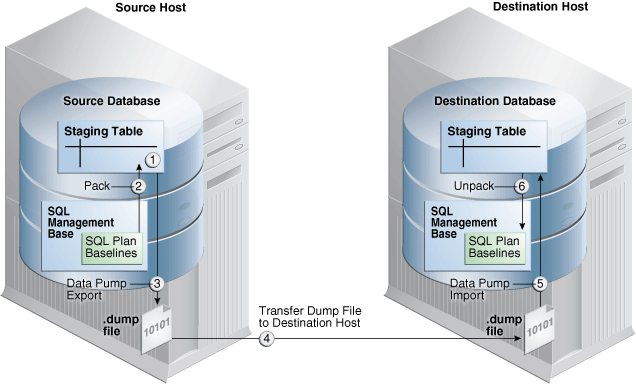
Description of the illustration tgsql_vm_006.png
This tutorial assumes the following:
-
You want to create a staging table named
stage1in the source database. -
You want to load all plans owned by user
spminto the staging table. -
You want to transfer the staging table to a destination database.
-
You want to load the plans in
stage1as fixed plans.
To transfer a set of SQL plan baselines from one database to another:
-
Connect SQL*Plus to the source database with the appropriate privileges, and then create a staging table using the
CREATE_STGTAB_BASELINEprocedure.The following example creates a staging table named
stage1:BEGIN DBMS_SPM.CREATE_STGTAB_BASELINE ( table_name => 'stage1'); END; / -
On the source database, pack the SQL plan baselines you want to export from the SQL management base into the staging table.
The following example packs enabled plan baselines created by user
spminto staging tablestage1. Select SQL plan baselines using the plan name (plan_name), SQL handle (sql_handle), or any other plan criteria. Thetable_nameparameter is mandatory.DECLARE my_plans number; BEGIN my_plans := DBMS_SPM.PACK_STGTAB_BASELINE ( table_name => 'stage1' , enabled => 'yes' , creator => 'spm' ); END; / -
Export the staging table
stage1into a dump file using Oracle Data Pump Export. -
Transfer the dump file to the host of the destination database.
-
On the destination database, import the staging table
stage1from the dump file using the Oracle Data Pump Import utility. -
On the destination database, unpack the SQL plan baselines from the staging table into the SQL management base.
The following example unpacks all fixed plan baselines stored in the staging table
stage1:DECLARE my_plans NUMBER; BEGIN my_plans := DBMS_SPM.UNPACK_STGTAB_BASELINE ( table_name => 'stage1' , fixed => 'yes' ); END; /
See Also:
-
Oracle Database PL/SQL Packages and Types Reference for more information about using the
DBMS_SPMpackage -
Oracle Database Utilities for detailed information about using the Data Pump Export and Import utilities
23.5 Evolving SQL Plan Baselines Manually
Oracle recommends that you configure the SQL Plan Management Evolve task to run automatically, as explained in "Managing the SPM Evolve Advisor Task". You can also use PL/SQL or Cloud Control to manually evolve an unaccepted plan to determine whether it performs better than any plan currently in the plan baseline.
This section contains the following topics:
23.5.1 About the DBMS_SPM Evolve Functions
Table 23-5 describes the most relevant DBMS_SPM procedures and functions for managing plan evolution. Execute evolution tasks manually or schedule them to run automatically.
Table 23-5 DBMS_SPM Functions and Procedures for Managing Plan Evolution Tasks
| Package | Procedure or Function | Description |
|---|---|---|
|
|
|
This function accepts one recommendation to evolve a single plan into a SQL plan baseline. |
|
|
|
This function creates an advisor task to prepare the plan evolution of one or more plans for a specified SQL statement. The input parameters can be a SQL handle, plan name or a list of plan names, time limit, task name, and description. |
|
|
|
This function executes an evolution task. The input parameters can be the task name, execution name, and execution description. If not specified, the advisor generates the name, which is returned by the function. |
|
|
|
This function implements all recommendations for an evolve task. Essentially, this function is equivalent to using |
|
|
|
This function displays the results of an evolve task as a |
|
|
|
This function updates the value of an evolve task parameter. In this release, the only valid parameter is |
Oracle recommends that you configure SPM Evolve Advisor to run automatically (see "Configuring the Automatic SPM Evolve Advisor Task"). You can also evolve SQL plan baselines manually. Figure 23-4 shows the basic workflow for managing SQL plan management tasks.
Typically, you manage SQL plan evolution tasks in the following sequence:
-
Create an evolve task
-
Optionally, set evolve task parameters
-
Execute the evolve task
-
Implement the recommendations in the task
-
Report on the task outcome
See Also:
Oracle Database PL/SQL Packages and Types Reference for information about theDBMS_SPM package23.5.2 Managing an Evolve Task
This section describes a typical use case in which you create and execute a task, and then implements its recommendations. Table 23-6 describes some parameters of the CREATE_EVOLVE_TASK function.
Table 23-6 DBMS_SPM.CREATE_EVOLVE_TASK Parameters
| Function Parameter | Description |
|---|---|
|
|
SQL handle of the statement. The default |
|
|
Plan identifier. The default |
|
|
Time limit in number of minutes. The time limit for first unaccepted plan equals the input value. The time limit for the second unaccepted plan equals the input value minus the time spent in first plan verification, and so on. The default |
|
|
User-specified name of the evolution task. |
This section explains how to evolve plan baselines from the command line. In Cloud Control, from the SQL Plan Baseline subpage (shown in Figure 23-3), select a plan, and then click Evolve.
This tutorial assumes the following:
-
You do not have the automatic evolve task enabled (see "Managing the SPM Evolve Advisor Task").
-
You want to create a SQL plan baseline for the following query:
SELECT /* q1_group_by */ prod_name, sum(quantity_sold) FROM products p, sales s WHERE p.prod_id = s.prod_id AND p.prod_category_id =203 GROUP BY prod_name;
-
You want to create two indexes to improve the query performance, and then evolve the plan that uses these indexes if it performs better than the plan currently in the plan baseline.
To evolve a specified plan:
-
Perform the initial setup as follows:
-
Connect SQL*Plus to the database with administrator privileges, and then prepare for the tutorial by flushing the shared pool and the buffer cache:
ALTER SYSTEM FLUSH SHARED_POOL; ALTER SYSTEM FLUSH BUFFER_CACHE;
-
Enable the automatic capture of SQL plan baselines.
For example, enter the following statement:
ALTER SYSTEM SET OPTIMIZER_CAPTURE_SQL_PLAN_BASELINES=true;
-
Connect to the database as user
sh, and then set SQL*Plus display parameters:CONNECT sh -- enter password SET PAGES 10000 LINES 140 SET SERVEROUTPUT ON COL SQL_TEXT FORMAT A20 COL SQL_HANDLE FORMAT A20 COL PLAN_NAME FORMAT A30 COL ORIGIN FORMAT A12 SET LONGC 60535 SET LONG 60535 SET ECHO ON
-
-
Execute the
SELECTstatements so that SQL plan management captures them:-
Execute the
SELECT /* q1_group_by */statement for the first time.Because the database only captures plans for repeatable statements, the plan baseline for this statement is empty.
-
Query the data dictionary to confirm that no plans exist in the plan baseline.
For example, execute the following query (sample output included):
SELECT SQL_HANDLE, SQL_TEXT, PLAN_NAME, ORIGIN, ENABLED, ACCEPTED, FIXED, AUTOPURGE FROM DBA_SQL_PLAN_BASELINES WHERE SQL_TEXT LIKE '%q1_group%'; no rows selectedSQL plan management only captures repeatable statements, so this result is expected.
-
Execute the
SELECT /* q1_group_by */statement for the second time.
-
-
Query the data dictionary to ensure that the plans were loaded into the plan baseline for the statement.
Example 23-4 executes the following query (sample output included).
Example 23-4 DBA_SQL_PLAN_BASELINES
SELECT SQL_HANDLE, SQL_TEXT, PLAN_NAME, ORIGIN, ENABLED, ACCEPTED, FIXED FROM DBA_SQL_PLAN_BASELINES WHERE SQL_TEXT LIKE '%q1_group%'; SQL_HANDLE SQL_TEXT PLAN_NAME ORIGIN ENA ACC FIX -------------------- -------------------- ------------------------------ ------------ --- --- --- SQL_07f16c76ff893342 SELECT /* q1_group_b SQL_PLAN_0gwbcfvzskcu242949306 AUTO-CAPTURE YES YES NO y */ prod_name, sum( quantity_sold) FROM products p, s ales s WHERE p.prod_id = s .prod_id AND p.prod_catego ry_id =203 GROUP BY prod_nameThe output shows that the plan is accepted, which means that it is in the plan baseline for the statement. Also, the origin is
AUTO-CAPTURE, which means that the statement was automatically captured and not manually loaded. -
Explain the plan for the statement and verify that the optimizer is using this plan.
For example, explain the plan as follows, and then display it:
EXPLAIN PLAN FOR SELECT /* q1_group_by */ prod_name, sum(quantity_sold) FROM products p, sales s WHERE p.prod_id = s.prod_id AND p.prod_category_id =203 GROUP BY prod_name; SELECT * FROM TABLE(DBMS_XPLAN.DISPLAY(null, null, 'basic +note'));
Sample output appears below:
Plan hash value: 1117033222 ------------------------------------------ | Id | Operation | Name | ------------------------------------------ | 0 | SELECT STATEMENT | | | 1 | HASH GROUP BY | | | 2 | HASH JOIN | | | 3 | TABLE ACCESS FULL | PRODUCTS | | 4 | PARTITION RANGE ALL| | | 5 | TABLE ACCESS FULL | SALES | ------------------------------------------ Note ----- - SQL plan baseline "SQL_PLAN_0gwbcfvzskcu242949306" used for this statement
The note indicates that the optimizer is using the plan shown with the plan name listed in Example 23-4.
-
Create two indexes to improve the performance of the
SELECT /* q1_group_by */statement.For example, use the following statements:
CREATE INDEX ind_prod_cat_name ON products(prod_category_id, prod_name, prod_id); CREATE INDEX ind_sales_prod_qty_sold ON sales(prod_id, quantity_sold);
-
Execute the
select /* q1_group_by */statement again.Because automatic capture is enabled, the plan baseline is populated with the new plan for this statement.
-
Query the data dictionary to ensure that the plan was loaded into the SQL plan baseline for the statement.
Example 23-5 executes the following query (sample output included).
Example 23-5 DBA_SQL_PLAN_BASELINES
SELECT SQL_HANDLE, SQL_TEXT, PLAN_NAME, ORIGIN, ENABLED, ACCEPTED FROM DBA_SQL_PLAN_BASELINES WHERE SQL_HANDLE IN ('SQL_07f16c76ff893342') ORDER BY SQL_HANDLE, ACCEPTED; SQL_HANDLE SQL_TEXT PLAN_NAME ORIGIN ENA ACC -------------------- -------------------- ------------------------------ ------------ --- --- SQL_07f16c76ff893342 SELECT /* q1_group_b SQL_PLAN_0gwbcfvzskcu20135fd6c AUTO-CAPTURE YES NO y */ prod_name, sum( quantity_sold) FROM products p, s ales s WHERE p.prod_id = s .prod_id AND p.prod_catego ry_id =203 GROUP BY prod_name SQL_07f16c76ff893342 SELECT /* q1_group_b SQL_PLAN_0gwbcfvzskcu242949306 AUTO-CAPTURE YES YES y */ prod_name, sum( quantity_sold) FROM products p, s ales s WHERE p.prod_id = s .prod_id AND p.prod_catego ry_id =203 GROUP BY prod_nameThe output shows that the new plan is unaccepted, which means that it is in the statement history but not the SQL plan baseline.
-
Explain the plan for the statement and verify that the optimizer is using the original nonindexed plan.
For example, explain the plan as follows, and then display it:
EXPLAIN PLAN FOR SELECT /* q1_group_by */ prod_name, sum(quantity_sold) FROM products p, sales s WHERE p.prod_id = s.prod_id AND p.prod_category_id =203 GROUP BY prod_name; SELECT * FROM TABLE(DBMS_XPLAN.DISPLAY(null, null, 'basic +note'));
Sample output appears below:
Plan hash value: 1117033222 ------------------------------------------ | Id | Operation | Name | ------------------------------------------ | 0 | SELECT STATEMENT | | | 1 | HASH GROUP BY | | | 2 | HASH JOIN | | | 3 | TABLE ACCESS FULL | PRODUCTS | | 4 | PARTITION RANGE ALL| | | 5 | TABLE ACCESS FULL | SALES | ------------------------------------------ Note ----- - SQL plan baseline "SQL_PLAN_0gwbcfvzskcu242949306" used for this statement
The note indicates that the optimizer is using the plan shown with the plan name listed in Example 23-4.
-
Connect as an administrator, and then create an evolve task that considers all SQL statements with unaccepted plans.
For example, execute the
DBMS_SPM.CREATE_EVOLVE_TASKfunction and then obtain the name of the task:CONNECT / AS SYSDBA VARIABLE cnt NUMBER VARIABLE tk_name VARCHAR2(50) VARIABLE exe_name VARCHAR2(50) VARIABLE evol_out CLOB EXECUTE :tk_name := DBMS_SPM.CREATE_EVOLVE_TASK( sql_handle => 'SQL_07f16c76ff893342', plan_name => 'SQL_PLAN_0gwbcfvzskcu20135fd6c'); SELECT :tk_name FROM DUAL;
The following sample output shows the name of the task:
:EVOL_OUT ------------------------------------------------------------------------------ TASK_11
Now that the task has been created and has a unique name, execute the task.
-
Execute the task.
For example, execute the
DBMS_SPM.EXECUTE_EVOLVE_TASKfunction (sample output included):EXECUTE :exe_name :=DBMS_SPM.EXECUTE_EVOLVE_TASK(task_name=>:tk_name); SELECT :exe_name FROM DUAL; :EXE_NAME ------------------------------------------------------------------------------- EXEC_1
-
View the report.
For example, execute the
DBMS_SPM.REPORT_EVOLVE_TASKfunction (sample output included):EXECUTE :evol_out := DBMS_SPM.REPORT_EVOLVE_TASK( task_name=>:tk_name, execution_name=>:exe_name ); SELECT :evol_out FROM DUAL; GENERAL INFORMATION SECTION ------------------------------------------------------------------------------ Task Information: --------------------------------------------- Task Name : TASK_11 Task Owner : SYS Execution Name : EXEC_1 Execution Type : SPM EVOLVE Scope : COMPREHENSIVE Status : COMPLETED Started : 01/09/2012 12:21:27 Finished : 01/09/2012 12:21:29 Last Updated : 01/09/2012 12:21:29 Global Time Limit : 2147483646 Per-Plan Time Limit : UNUSED Number of Errors : 0 ------------------------------------------------------------------------------- SUMMARY SECTION ------------------------------------------------------------------------------- Number of plans processed : 1 Number of findings : 1 Number of recommendations : 1 Number of errors : 0 ------------------------------------------------------------------------------- DETAILS SECTION ------------------------------------------------------------------------------- Object ID : 2 Test Plan Name : SQL_PLAN_0gwbcfvzskcu20135fd6c Base Plan Name : SQL_PLAN_0gwbcfvzskcu242949306 SQL Handle : SQL_07f16c76ff893342 Parsing Schema : SH Test Plan Creator : SH SQL Text : SELECT /* q1_group_by */ prod_name, sum(quantity_sold) FROM products p, sales s WHERE p.prod_id = s.prod_id AND p.prod_category_id =203 GROUP BY prod_name Execution Statistics: ----------------------------- Base Plan Test Plan ---------------------------- ---------------------------- Elapsed Time (s): .044336 .012649 CPU Time (s): .044003 .012445 Buffer Gets: 360 99 Optimizer Cost: 924 891 Disk Reads: 341 82 Direct Writes: 0 0 Rows Processed: 4 2 Executions: 5 9 FINDINGS SECTION ------------------------------------------------------------------------------- Findings (1): ----------------------------- 1. The plan was verified in 2.18 seconds. It passed the benefit criterion because its verified performance was 2.01 times better than that of the baseline plan. Recommendation: ----------------------------- Consider accepting the plan. Execute dbms_spm.accept_sql_plan_baseline(task_name => 'TASK_11', object_id => 2, task_owner => 'SYS'); EXPLAIN PLANS SECTION ------------------------------------------------------------------------------- Baseline Plan ----------------------------- Plan Id : 1 Plan Hash Value : 1117033222 ------------------------------------------------------------------------------- | Id| Operation | Name | Rows | Bytes | Cost | Time | ------------------------------------------------------------------------------- | 0 | SELECT STATEMENT | | 21 | 861 | 924 | 00:00:12| | 1 | HASH GROUP BY | | 21 | 861 | 924 | 00:00:12| | *2| HASH JOIN | | 267996 | 10987836 | 742 | 00:00:09| | *3| TABLE ACCESS FULL | PRODUCTS | 21 | 714 | 2 | 00:00:01| | 4 | PARTITION RANGE ALL | | 918843 | 6431901 | 662 | 00:00:08| | 5 | TABLE ACCESS FULL | SALES | 918843 | 6431901 | 662 | 00:00:08| ------------------------------------------------------------------------------ Predicate Information (identified by operation id): ------------------------------------------ * 2 - access("P"."PROD_ID"="S"."PROD_ID") * 3 - filter("P"."PROD_CATEGORY_ID"=203) Test Plan ----------------------------- Plan Id : 2 Plan Hash Value : 20315500 ------------------------------------------------------------------------------- |Id| Operation | Name | Rows | Bytes | Cost| Time| ------------------------------------------------------------------------------- | 0|SELECT STATEMENT | | 21| 861|891|00:00:11 | 1| SORT GROUP BY NOSORT| | 21| 861|891|00:00:11 | 2| NESTED LOOPS | |267996|10987836|891|00:00:11 |*3| INDEX RANGE SCAN |IND_PROD_CAT_NAME | 21| 714| 1|00:00:01 |*4| INDEX RANGE SCAN |IND_SALES_PROD_QTY_SOLD| 12762| 89334| 42|00:00:01 ------------------------------------------------------------------------------- Predicate Information (identified by operation id): ------------------------------------------ * 3 - access("P"."PROD_CATEGORY_ID"=203) * 4 - access("P"."PROD_ID"="S"."PROD_ID")This report indicates that the new execution plan, which uses the two new indexes, performs better than the original plan.
-
Implement the recommendations of the evolve task.
For example, execute the
IMPLEMENT_EVOLVE_TASKfunction:EXECUTE :cnt := DBMS_SPM.IMPLEMENT_EVOLVE_TASK( task_name=>:tk_name, execution_name=>:exe_name );
-
Query the data dictionary to ensure that the new plan is accepted.
Example 23-5 executes the following query (sample output included).
Example 23-6 DBA_SQL_PLAN_BASELINES
SQL_HANDLE SQL_TEXT PLAN_NAME ORIGIN ENA ACC -------------------- -------------------- ------------------------------ ------------ --- --- SQL_07f16c76ff893342 SELECT /* q1_group_b SQL_PLAN_0gwbcfvzskcu20135fd6c AUTO-CAPTURE YES YES y */ prod_name, sum( quantity_sold) FROM products p, s ales s WHERE p.prod_id = s .prod_id AND p.prod_catego ry_id =203 GROUP BY prod_name SQL_07f16c76ff893342 SELECT /* q1_group_b SQL_PLAN_0gwbcfvzskcu242949306 AUTO-CAPTURE YES YES y */ prod_name, sum( quantity_sold) FROM products p, s ales s WHERE p.prod_id = s .prod_id AND p.prod_catego ry_id =203 GROUP BY prod_nameThe output shows that the new plan is accepted.
-
Clean up after the example.
For example, enter the following statements:
EXEC :cnt := DBMS_SPM.DROP_SQL_PLAN_BASELINE('SQL_07f16c76ff893342'); EXEC :cnt := DBMS_SPM.DROP_SQL_PLAN_BASELINE('SQL_9049245213a986b3'); EXEC :cnt := DBMS_SPM.DROP_SQL_PLAN_BASELINE('SQL_bb77077f5f90a36b'); EXEC :cnt := DBMS_SPM.DROP_SQL_PLAN_BASELINE('SQL_02a86218930bbb20'); DELETE FROM SQLLOG$; CONNECT sh -- enter password DROP INDEX IND_SALES_PROD_QTY_SOLD; DROP INDEX IND_PROD_CAT_NAME;
See Also:
Oracle Database PL/SQL Packages and Types Reference for information about using theDBMS_SPM evolve functions23.6 Dropping SQL Plan Baselines
You can remove some or all plans from a SQL plan baseline. This technique is sometimes useful when testing SQL plan management.
Drop plans with the DBMS_SPM.DROP_SQL_PLAN_BASELINE function. This function returns the number of dropped plans. Table 23-8 describes input parameters.
Table 23-7 DROP_SQL_PLAN_BASELINE Parameters
| Function Parameter | Description |
|---|---|
|
|
SQL statement identifier. |
|
|
Name of a specific plan. Default |
This section explains how to drop baselines from the command line. In Cloud Control, from the SQL Plan Baseline subpage (shown in Figure 23-3), select a plan, and then click Drop.
This tutorial assumes that you want to drop all plans for the following SQL statement, effectively dropping the SQL plan baseline:
SELECT /* repeatable_sql */ COUNT(*) FROM hr.jobs;
To drop a SQL plan baseline:
-
Connect SQL*Plus to the database with the appropriate privileges, and then query the data dictionary for the plan baseline.
Example 23-7 executes the following query (sample output included).
Example 23-7 DBA_SQL_PLAN_BASELINES
SQL> SELECT SQL_HANDLE, SQL_TEXT, PLAN_NAME, ORIGIN, 2 ENABLED, ACCEPTED 3 FROM DBA_SQL_PLAN_BASELINES 4 WHERE SQL_TEXT LIKE 'SELECT /* repeatable_sql%'; SQL_HANDLE SQL_TEXT PLAN_NAME ORIGIN ENA ACC -------------------- -------------------- ------------------------------ -------------- --- --- SQL_b6b0d1c71cd1807b SELECT /* repeatable SQL_PLAN_bdc6jswfd303v2f1e9c20 AUTO-CAPTURE YES YES _sql */ count(*) fro m hr.jobs -
Drop the SQL plan baseline for the statement.
The following example drops the plan baseline with the SQL handle
SQL_b6b0d1c71cd1807b, and returns the number of dropped plans. Specify plan baselines using the plan name (plan_name), SQL handle (sql_handle), or any other plan criteria. Thetable_nameparameter is mandatory.DECLARE v_dropped_plans number; BEGIN v_dropped_plans := DBMS_SPM.DROP_SQL_PLAN_BASELINE ( sql_handle => 'SQL_b6b0d1c71cd1807b' ); DBMS_OUTPUT.PUT_LINE('dropped ' || v_dropped_plans || ' plans'); END; / -
Confirm that the plans were dropped.
For example, execute the following query:
SELECT SQL_HANDLE, SQL_TEXT, PLAN_NAME, ORIGIN, ENABLED, ACCEPTED FROM DBA_SQL_PLAN_BASELINES WHERE SQL_TEXT LIKE 'SELECT /* repeatable_sql%'; no rows selected
See Also:
Oracle Database PL/SQL Packages and Types Reference to learn about theDROP_SQL_PLAN_BASELINE function23.7 Managing the SQL Management Base
The SQL management base is a part of the data dictionary that resides in the SYSAUX tablespace. It stores statement logs, plan histories, SQL plan baselines, and SQL profiles. This section explains how to change the disk space usage parameters for the SMB, and change the retention time for plans in the SMB.
The DBA_SQL_MANAGEMENT_CONFIG view shows the current configuration settings for the SMB. Table 23-8 describes the parameters in the PARAMETER_NAME column.
Table 23-8 Parameters in DBA_SQL_MANAGEMENT_CONFIG.PARAMETER_NAME
| Parameter | Description |
|---|---|
|
|
Maximum percent of |
|
|
Number of weeks to retain unused plans before they are purged. The default is 53. |
23.7.1 Changing the Disk Space Limit for the SMB
A weekly background process measures the total space occupied by the SMB. When the defined limit is exceeded, the process writes a warning to the alert log. The database generates alerts weekly until either the SMB space limit is increased, the size of the SYSAUX tablespace is increased, or the disk space used by the SMB is decreased by purging SQL management objects (SQL plan baselines or SQL profiles). This task explains how to change the limit with the DBMS_SPM.CONFIGURE procedure.
This tutorial assumes the following:
-
The current SMB space limit is the default of 10%.
-
You want to change the percentage limit to 30%
To change the percentage limit of the SMB:
-
Connect SQL*Plus to the database with the appropriate privileges, and then query the data dictionary to see the current space budget percent.
For example, execute the following query (sample output included):
SELECT PARAMETER_NAME, PARAMETER_VALUE AS "%_LIMIT", ( SELECT sum(bytes/1024/1024) FROM DBA_DATA_FILES WHERE TABLESPACE_NAME = 'SYSAUX' ) AS SYSAUX_SIZE_IN_MB, PARAMETER_VALUE/100 * ( SELECT sum(bytes/1024/1024) FROM DBA_DATA_FILES WHERE TABLESPACE_NAME = 'SYSAUX' ) AS "CURRENT_LIMIT_IN_MB" FROM DBA_SQL_MANAGEMENT_CONFIG WHERE PARAMETER_NAME = 'SPACE_BUDGET_PERCENT'; PARAMETER_NAME %_LIMIT SYSAUX_SIZE_IN_MB CURRENT_LIMIT_IN_MB ------------------------------ ---------- ----------------- ------------------- SPACE_BUDGET_PERCENT 10 211.4375 21.14375 -
Change the percentage setting.
For example, execute the following command to change the setting to 30%:
EXECUTE DBMS_SPM.CONFIGURE('space_budget_percent',30); -
Query the data dictionary to confirm the change.
For example, execute the following join (sample output included):
SELECT PARAMETER_NAME, PARAMETER_VALUE AS "%_LIMIT", ( SELECT sum(bytes/1024/1024) FROM DBA_DATA_FILES WHERE TABLESPACE_NAME = 'SYSAUX' ) AS SYSAUX_SIZE_IN_MB, PARAMETER_VALUE/100 * ( SELECT sum(bytes/1024/1024) FROM DBA_DATA_FILES WHERE TABLESPACE_NAME = 'SYSAUX' ) AS "CURRENT_LIMIT_IN_MB" FROM DBA_SQL_MANAGEMENT_CONFIG WHERE PARAMETER_NAME = 'SPACE_BUDGET_PERCENT'; PARAMETER_NAME %_LIMIT SYSAUX_SIZE_IN_MB CURRENT_LIMIT_IN_MB ------------------------------ ---------- ----------------- ------------------- SPACE_BUDGET_PERCENT 30 211.4375 63.43125
23.7.2 Changing the Plan Retention Policy in the SMB
A weekly scheduled purging task manages disk space used by SQL plan management. The task runs as an automated task in the maintenance window. The database purges plans that have not been used for longer than the plan retention period, as identified by the LAST_EXECUTED timestamp stored in the SMB for that plan. The default retention period is 53 weeks. The period can range between 5 and 523 weeks.
This task explains how to change the plan retention period with the DBMS_SPM.CONFIGURE procedure. In Cloud Control, set the plan retention policy in the SQL Plan Baseline subpage (shown in Figure 23-3).
To change the plan retention period for the SMB:
-
Connect SQL*Plus to the database with the appropriate privileges, and then query the data dictionary to see the current plan retention period.
For example, execute the following query (sample output included):
SQL> SELECT PARAMETER_NAME, PARAMETER_VALUE 2 FROM DBA_SQL_MANAGEMENT_CONFIG 3 WHERE PARAMETER_NAME = 'PLAN_RETENTION_WEEKS'; PARAMETER_NAME PARAMETER_VALUE ------------------------------ --------------- PLAN_RETENTION_WEEKS 53
-
Change the retention period.
For example, execute the
CONFIGUREprocedure to change the period to 105 weeks:EXECUTE DBMS_SPM.CONFIGURE('plan_retention_weeks',105); -
Query the data dictionary to confirm the change.
For example, execute the following query:
SQL> SELECT PARAMETER_NAME, PARAMETER_VALUE 2 FROM DBA_SQL_MANAGEMENT_CONFIG 3 WHERE PARAMETER_NAME = 'PLAN_RETENTION_WEEKS'; PARAMETER_NAME PARAMETER_VALUE ------------------------------ --------------- PLAN_RETENTION_WEEKS 105
See Also:
Oracle Database PL/SQL Packages and Types Reference to learn about theDBMS_SPM.CONFIGURE procedure